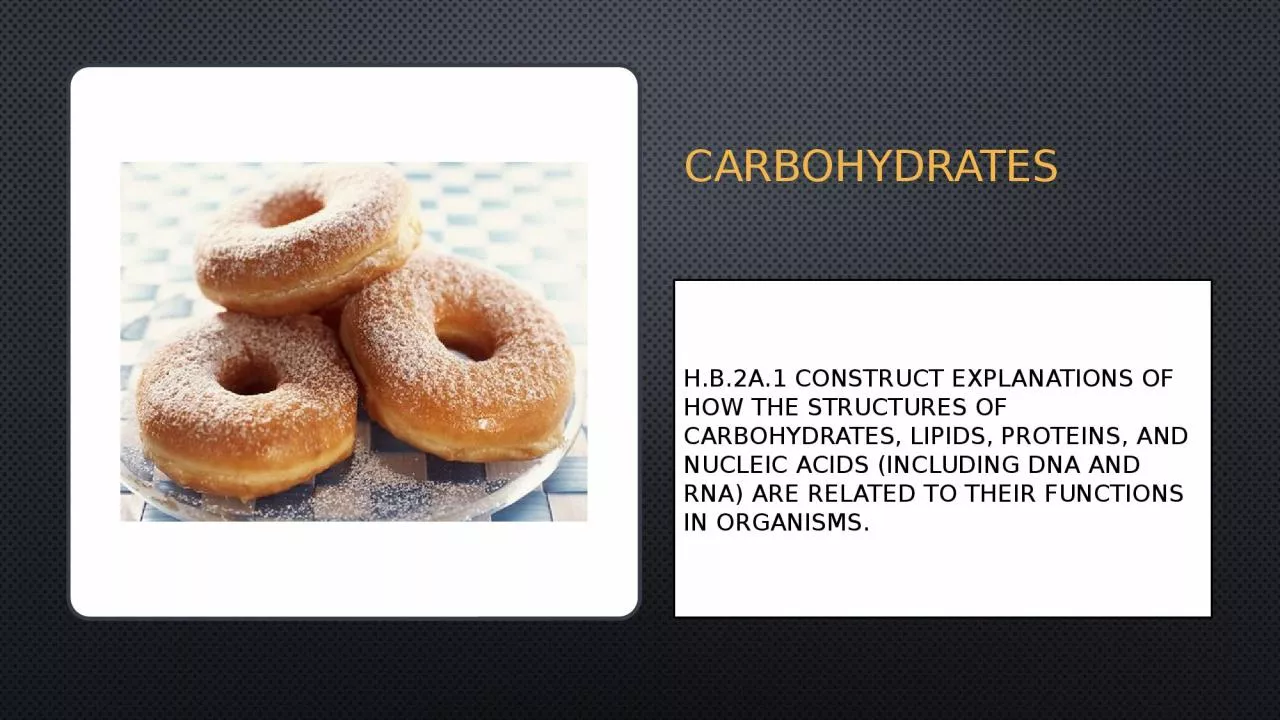

Carbohydrates Are the most common type of organic compound Examples Starch or sugar Is used to store energy Are built in repeating units to make a larger molecule Contain only carbon hydrogen and oxygen ID: 930454
Download Presentation The PPT/PDF document "carbohydrates H.B.2A.1 Construct explana..." is the property of its rightful owner. Permission is granted to download and print the materials on this web site for personal, non-commercial use only, and to display it on your personal computer provided you do not modify the materials and that you retain all copyright notices contained in the materials. By downloading content from our website, you accept the terms of this agreement.
Slide1
carbohydrates
H.B.2A.1 Construct explanations of how the structures of carbohydrates, lipids, proteins, and nucleic acids (including DNA and RNA) are related to their functions in organisms.
Slide2Carbohydrates
Are the most common type of organic compoundExamples: Starch or sugarIs used to store energyAre built in repeating units to make a larger moleculeContain only carbon, hydrogen, and oxygen
Slide3Monosaccharides
A monosaccharide is a simple sugar such as fructose or glucoseGlucose (C6H12O6) is used for energy by the cells of most organisms, and is a product of photosynthesisThe general formula for a
monosaccharide is:(CH2O)nwhere
n can be any number greater than two. For example, in glucose n is 6, and the formula is:C6H12O6
Slide4disaccharideIf two monosaccharides bond together, they form a carbohydrate called a disaccharideExample: Sucrose (table sugar) is made of two monosaccharides glucose and fructose
Monosaccharides and disaccharides are called "simple" sugarsThey provide the major source of energy to living cells
Slide5Polysaccharides
A polysaccharide is a complex carbohydrate that forms when simple sugars bind together in a chain.Polysaccharides may contain just a few simple sugars or thousands of them.Complex carbohydrates have two main functions: storing energy and forming structures of living things.
Slide6Examples of polysaccharides
NameFunctionExamplestarch
Used by plants to store energyA potato stores starch in underground tubers
glycogenUsed by animals to store energy.
A human stores glycogen in liver cells
cellulose
Used by plants to form rigid walls around cells.
Plants use cellulose for their cell walls.
chitin
Used by some animals to form an external skeleton.
A housefly uses chitin for its exoskeleton
Slide7reviewWhat is a carbohydrate?
List three facts about glucose.Assume that you are trying to identify an unknown organic molecule. It contains only carbon, hydrogen, and oxygen and is found in the cell walls of a newly discovered plant species. What type of organic compound is it? Why?Compare and contrast the structures and functions of simple sugars and complex carbohydrates.